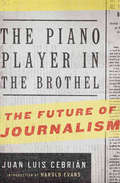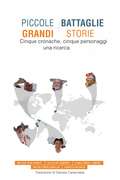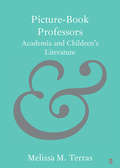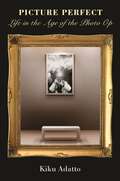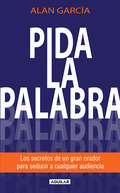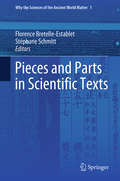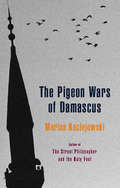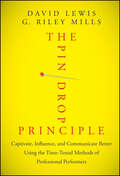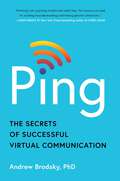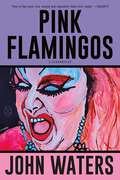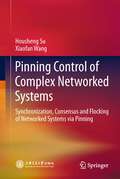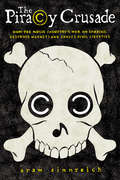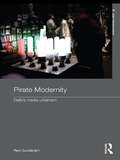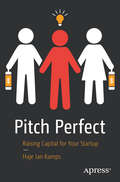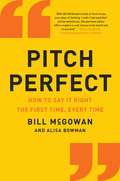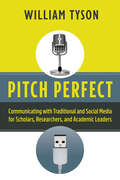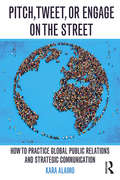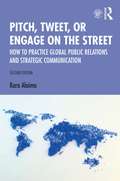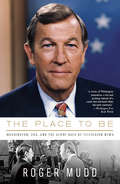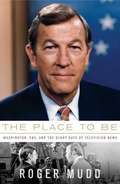- Table View
- List View
The Piano Player in the Brothel: The Future of Journalism
by Juan Luis Cebrián“The first director of the Spanish newspaper El País, offers his reflections on the state of the press in pithy essays peppered with quips and aphorisms” (The New Yorker). For veteran journalist Juan Luis Cebrián, there is wisdom in the old joke that it is better to be anything other than a journalist, including a piano player in a brothel. In this incisive collection of essays, Cebrián discusses the importance of journalism through modern history, its imperiled state in today’s media landscape, and what will be required to maintain an independent press in the years to come. Cebrián explores the significance of journalism on the world stage, discussing topics that range from the Watergate scandal to modern terrorism. Recalling the repression of newspapers in Spain under Francisco Franco, and the struggle to rebuild a free press when democracy was restored, Cebrián offers an analysis of the new challenges facing the journalists of today, for whom censorship is less a matter of political strong-arming than the structural realities of the Internet.
The Piano Player in the Brothel: The Future of Journalism
by Eduardo Schmid Jean Luis CebrianThe book's title refers to the classic joke in which a father tells his son that anything is better than being a journalist, including being a piano player in the brothel. The Piano Player in the Brothel is a reflection on the practice of journalism and the responsibility it entails in the interpretation of an ever-changing and increasingly complex world. The author's thoughts are interspersed with data and anecdotes on the history of journalism and its role as a great instrument of cultural diffusion, a warrantor of freedom of speech, and, hence, a protector of democracy. From its origins, journalism has struggled with political power -always interested in turning information into simple propaganda- and for that purpose it has developed some basic principles: truthfulness, verification, independence, public commitment and loyalty towards the citizens.
Piccole battaglie, grandi storie
by Daniela Caracostas Melissa Silva Franco Nilton Varillas TorresIl libro è la raccolta di cinque racconti di cronaca realizzati da cinque giornalisti latinoamericani. Prologo di Roberto Herrscher, giornalista, reporter specializzato in cultura, società e ambiente, e professore di giornalismo. Laureato in Sociologia presso l’Università di Buenos Aires con Master in Giornalismo alla Columbia University. Dirige e insegna nel Master di Giornalismo BCN_NY, organizzato dalla IL3-Università di Barcellona e l’Università di Columbia a New York. Corrispondente in Spagna della rivista Opera News. Ha impartito lezioni e seminari presso l’Ithaca College (USA), l’Università degli Studi di Milano, Colonia (Germania), Católica de Valparaíso e Finis Terrae (Cile) e insegna nel Master di Giornalismo di Clarín/San Andrés (Argentina), dell’Universidad Complutense di Madrid/ABC (Spagna), tra le altre. Cinque le cronache giornalistiche, cinque i loro autori: 1- La giornalista venezuelana Melissa Silva inizia la serie fornendo il ritratto di un’anziana donna della Corea, Gil Won, che rivela la sua storia e quella di altre 200mila adolescenti durante la Seconda Guerra Mondiale, quando furono sequestrate e violentate e trasformate in “Donne di conforto”. Una storia ancora non raccontata della Seconda Guerra Mondiale. 2- Il giornalista peruviano Luis Felipe Gamarra segue il padre di un poliziotto morto in un torbido scontro con gli indigeni in rivolta. Anche la lotta di Felipe Bazán Caballero è per la memoria e la dignità del figlio. Il suo ultimo ritratto: una foto con il volto insanguinato, scattata mentre tentava di sgomberare una strada dell’ Amazzonia peruviana occupata dagli abitanti della zona. Il padre vuole ritrovarlo, vivo o morto che sia. 3- Il cronista peruviano Nilton Torres Varillas si cimenta con un avventuriero catalano, Anselm Pi, che trovò la Chinkana, un segreto preispanico che la Chiesa non vuole rivelare perché potrebbe cambiare la storia…
Picture-Book Professors: Academia and Children's Literature (Elements in Publishing and Book Culture)
by Melissa TerrasHow is academia portrayed in children's literature? This Element ambitiously surveys fictional professors in texts marketed towards children, who are overwhelmingly white and male, tending to be elderly scientists. Professors fall into three stereotypes: the vehicle to explain scientific facts, the baffled genius, and the evil madman. By the late twentieth century, the stereotype of the male, mad, muddlehead, called Professor SomethingDumb, is formed in humorous yet pejorative fashion. This Element provides a publishing history of the role of academics in children's literature, questioning the book culture which promotes the enforcement of stereotypes regarding intellectual expertise in children's media. This title is also available, with additional material, as Open Access.
Picture Perfect: Life in the Age of the Photo Op - New Edition
by Kiku AdattoWe say the camera doesn't lie, but we also know that pictures distort and deceive. In Picture Perfect, Kiku Adatto brilliantly examines the use and abuse of images today. Ranging from family albums to Facebook, political campaigns to popular movies, images of war to pictures of protest. Adatto reveals how the line between the person and the pose, the real and the fake, news and entertainment is increasingly blurred. New technologies make it easier than ever to capture, manipulate, and spread images. But even in the age of the Internet, we still seek authentic pictures and believe in the camera's promise to document, witness, and interpret our lives.
Pida la palabra. Los secretos de un gran orador para seducir a cualquier audiencia.: Los secretos de un gran orador para seducir a cualquier audiencia
by García AlanPierda el miedo al escenario y descubra cómo conquistar y seducir al auditorio. Durante muchos años se creyó que memorizar un discurso era fundamental para exponer las ideas de manera incuestionable. Gran error. El orador debe confiar en su memoria, sí, pero más en la capacidad de ser uno con el público, debe permitir que las ideas fluyan, que el cuerpo exprese la exaltación y los gestos sean un vocablo potente y digno. Si el expositor es un hombre audaz e instruido, no es indispensable encomendarse a la memoria, mucho menos leer un documento, para fundamentar sus convicciones.En este libro esencial para aprender a dirigirse al público, dominar el escenario y someter nuestros miedos, el destacado político y ex presidente de Perú, el doctor Alan García #además extraordinario orador- ofrece los secretos para hacer de la palabra, acción compartida. En estas páginas habla de la importancia de una dicción clara yfuerte, del manejo del cuerpo, de la necesidad de mantener una presencia indeclinable y del dominio de los temas.Revela que es indispensable hablar fuerte y con decisión, preparar con seriedad la exposición y acudir al ejemplo de discursos inolvidables. Por esta razón y con el fin de hacer más contundente este libro, analiza y celebra textos inmortales de William Shakespeare, Martin Luther King, Jesucristo, Franklin D. Roosevelt, Haya de la Torre, Kennedy, entre otros grandes personajes, sin soslayar el ritmo, la música y la potencia sonora de versos de Santos Chocano, Neruda o García Lorca.Pida la palabra es el libro que transformará la forma en que se elabora un discurso y la manera infalible de hacer que los auditorios se entreguen, conmovidos, a la emotividad y convicción del orador.
Pieces and Parts in Scientific Texts (Why the Sciences of the Ancient World Matter #1)
by Florence Bretelle-Establet Stéphane SchmittThis book starts from a first general observation: there are very diverse ways to frame and convey scientific knowledge in texts. It then analyzes texts on mathematics, astronomy, medicine and life sciences, produced in various parts of the globe and in different time periods, and examines the reasons behind the segmentation of texts and the consequences of such textual divisions. How can historians and philosophers of science approach this diversity, and what is at stake in dealing with it? The book addresses these questions, adopting a specific approach to do so. In order to shed light on the diversity of organizational patterns and rhetorical strategies in scientific texts, and to question the rationale behind the choices made to present such texts in one particular way, it focuses on the issue of text segmentation, offering answers to questions such as: What was the meaning of segmenting texts into paragraphs, chapters, sections and clusters? Was segmentation used to delimit self-contained units, or to mark breaks in the physical appearance of a text in order to aid reading and memorizing, or to cope with the constraints of the material supports? How, in these different settings and in different texts, were pieces and parts made visible?
The Pigeon Wars of Damascus
by Marius KociejowskiMarius Kociejowski follows up his now classic The Street Philosopher and the Holy Fool with The Pigeon Wars of Damascus. A metaphysical journalist in search of echoes rather than analogies, hints as opposed to verities, Kociejowski discovers once again at the periphery of Damascene society-for the outcast is often made of the very thing that rejects him-a way to understand the challenges and changes refashioning post-9/11 Syria and the Middle East, reminding us once again of the deeper purpose of travel: to absorb and understand the spirit of a place, and to return changed.
The Pin Drop Principle: Captivate, Influence, and Communicate Better Using the Time-Tested Methods of Professional Performers
by David Lewis G. Riley MillsTap into the powerful techniques of professional actors and great communicators The Pin Drop Principle is a step-by-step master class for anyone wishing to become a more confident and credible communicator. Lewis and Mills believe all business professionals ought to deliver their message in such an engaging way that one could literally hear a pin drop when they speak. The secret to doing so comes from an unusual world: professional acting. By activating "objective" and "intention"—the main tools of actors (and great communicators)—business people can give their messages meaning and relevance, so the recipients walk away knowing why the message is important and what is in it for them. Empowers business professionals with performance-based delivery techniques—from storytelling to vocal dynamics—essential to becoming a great communicator Written for anyone wishing to engage listeners, establish instant credibility, influence key decision makers, and create a positive lasting impression Based on the Pinnacle Method, one of the most popular and groundbreaking communication skills training methods The Pin Drop Principle is an accessible resource for anyone who routinely needs to present ideas to large or small groups, convey feedback effectively, conduct difficult conversations, and persuade others.
Ping: The Secrets of Successful Virtual Communication
by Andrew BrodskyThe essential guide for when (and how best) to use virtual communication tools, from video to instant messaging and everything in between.Award-winning professor, management consultant, and virtual communications expert Andrew Brodsky is here to tell you that, yes, that meeting could have been an email. And that email? Maybe it should have been a voice note (really!). And your camera—it&’s okay to turn it off; sometimes it&’s even better. If you&’re crushed under the weight of your inbox or exhausted from back-to-back-to-back video calls, then Ping is here to help workers at all levels and of all stripes—remote, hybrid, and in person—who use communication technologies as part of their jobs. Split into three parts, this book tackles the core components of how to better navigate communication challenges and technology in contemporary workplaces. Brodsky addresses critical topics such as: -When to choose an email, instant message, or video call -How to make better virtual first impressions -Methods for optimizing communication productivity -How to build strong relationships at a distance -Ways to win negotiations and solve conflicts from behind a screen -And more With enlightening stories, interviews with top business leaders, and Brodsky&’s cutting-edge social science research on virtual communication tools, Ping is the necessary playbook for mastering virtual communication to increase productivity, gain influence, and deepen connections.
Pink Flamingos: A Screenplay
by John WatersThe return of a spectacular, reviled, and iconic classic of American filth! John Waters takes us back to the scene of his original crime against good taste. Watch as Babs Johnson fights to hold on to her title as “Filthiest Person Alive,“ fending off the craven attempts to dethrone her by her nemeses Connie and Raymond Marble.Read along as Waters takes us on a romp through his camp and filthy vision of Baltimore, from nefarious baby-stealing lesbians to scenes of unspeakable things done to unsuspecting chickens, to the film’s iconic and revolting coup de grace (no spoilers, but it is just as stomach-churning on the page more than fifty years later!). Pink Flamingos is John Waters at his provocative, disgusting, piety-puncturing best, with the hellish and hilarious trash masterpiece that first made him a household name.
Pinning Control of Complex Networked Systems
by Housheng Su Xiaofan WangSynchronization, consensus and flocking are ubiquitous requirements in networked systems. Pinning Control of Complex Networked Systems investigates these requirements by using the pinning control strategy, which aims to control the whole dynamical network with huge numbers of nodes by imposing controllers for only a fraction of the nodes. As the direct control of every node in a dynamical network with huge numbers of nodes might be impossible or unnecessary, it's then very important to use the pinning control strategy for the synchronization of complex dynamical networks. The research on pinning control strategy in consensus and flocking of multi-agent systems can not only help us to better understand the mechanisms of natural collective phenomena, but also benefit applications in mobile sensor/robot networks. This book offers a valuable resource for researchers and engineers working in the fields of control theory and control engineering. Housheng Su is an Associate Professor at the Department of Control Science and Engineering, Huazhong University of Science and Technology, China; Xiaofan Wang is a Professor at the Department of Automation, Shanghai Jiao Tong University, China.
Pip and Bunny: Pip at Home (Supporting Language and Emotional Development in the Early Years through Reading)
by Maureen GlynnPip at Home is the sixth book in the invaluable ‘Pip and Bunny’ collection; a set of six picture books with an accompanying handbook and e-resources carefully written and illustrated to support the development of visual and literary skills. By inspiring conversation and imagination, the books promote emotional and social literacy in the young reader. Designed for use within the early years setting or at home, each story explores different areas of social and emotional development. The full set includes: six beautifully illustrated picture books with text and vocabulary for each a handbook designed to guide the adult in using the books effectively ‘Talking Points’ relating to the child’s own world ‘What’s the Word?’ picture pages to be photocopied, downloaded or printed for language development detailed suggestions as to how to link with other EYFS areas of learning. The set is designed to be used in both individual and group settings. It will be a valuable resource for teachers, SENCOs (pre-school and reception), Early Years Staff (nursery, preschool and reception), EOTAs, Educational Psychologists, Counsellors and Speech Therapists.
The Piracy Crusade: How the Music Industry's War on Sharing Destroys Markets and Erodes Civil Liberties
by Aram SinnreichIn the decade and a half since Napster first emerged, forever changing the face of digital culture, the claim that "internet pirates killed the music industry" has become so ubiquitous that it is treated as common knowledge. Piracy is a scourge on legitimate businesses and hard-working artists, we are told, a "cybercrime" similar to identity fraud or even terrorism. In The Piracy Crusade, Aram Sinnreich critiques the notion of "piracy" as a myth perpetuated by today's cultural cartels--the handful of companies that dominate the film, software, and especially music industries. As digital networks have permeated our social environment, they have offered vast numbers of people the opportunity to experiment with innovative cultural and entrepreneurial ideas predicated on the belief that information should be shared widely. This has left the media cartels, whose power has historically resided in their ability to restrict the flow of cultural information, with difficult choices: adapt to this new environment, fight the changes tooth and nail, or accept obsolescence. Their decision to fight has resulted in ever stronger copyright laws and the aggressive pursuit of accused infringers. Yet the most dangerous legacy of this "piracy crusade" is not the damage inflicted on promising start-ups or on well-intentioned civilians caught in the crosshairs of file-sharing litigation. Far more troubling, Sinnreich argues, are the broader implications of copyright laws and global treaties that sacrifice free speech and privacy in the name of combating the phantom of piracy--policies that threaten to undermine the foundations of democratic society.
Pirate Modernity: Delhi's Media Urbanism (Routledge Studies in Asia's Transformations)
by Ravi SundaramUsing Delhi’s contemporary history as a site for reflection, Pirate Modernity moves from a detailed discussion of the technocratic design of the city by US planners in the 1950s, to the massive expansions after 1977, culminating in the urban crisis of the 1990s. As a practice, pirate modernity is an illicit form of urban globalization. Poorer urban populations increasingly inhabit non-legal spheres: unauthorized neighborhoods, squatter camps and bypass legal technological infrastructures (media, electricity). This pirate culture produces a significant enabling resource for subaltern populations unable to enter the legal city. Equally, this is an unstable world, bringing subaltern populations into the harsh glare of permanent technological visibility, and attacks by urban elites, courts and visceral media industries. The book examines contemporary Delhi from some of these sites: the unmaking of the citys modernist planning design, new technological urban networks that bypass states and corporations, and the tragic experience of the road accident terrifyingly enhanced by technological culture. Pirate Modernity moves between past and present, along with debates in Asia, Africa and Latin America on urbanism, media culture, and everyday life. This pioneering book suggests cities have to be revisited afresh after proliferating media culture. Pirate Modernity boldly draws from urban and cultural theory to open a new agenda for a world after media urbanism.
Pitch Perfect: Raising Capital for Your Startup
by Haje Jan KampsYou have a home-run startup idea and a whip-smart team to execute it. Everything should be in place to kick-start your company and secure funding. However, there is one more step that can make or break the entire deal: the pitch. Founders everywhere struggle to nail the perfect pitch to garner VC backing, and this book is here to help.Pitch Perfect by Haje Jan Kamps expertly teaches you how to tell your startup’s story. To raise venture capital, it is absolutely crucial that your foundation is a story that is accessible, compelling, and succinct. Kamps uses his invaluable experiential knowledge to guide you through your presentation, from slide deck specifics to storytelling details to determining a fundamental philosophy for your business. In the process of creating and formulating a pitch deck and the story to go with it, founders often discover deep flaws in their business idea. Perhaps the market is non-existent. It could be that the “problem” isn’t worth solving. Maybe the idea is so simple that it would be too easy to copy. Maybe it’s already been done, or the team simply is not up to the job. Pitch Perfect has all of those bases covered so that you can excel.How do you convince an institutional investor to part with their money and fund your company? The small block of time you are given for a pitch holds your startup’s future in its grasp. Learn how to craft your startup story in a way that will get people to lean into your message with Pitch Perfect. Your dream is only one pitch away.
Pitch Perfect: How to Say It Right the First Time, Every Time
by Bill McgowanThe media coach and Emmy Award-winning correspondent Bill McGowan shares his secrets of pitch-perfect communications, showing readers how to communicate with confidence.During the pivotal moments of our lives, results are often determined not only by our actions but by our words as well. Saying the right thing the right way can make the difference between sealing the deal or losing the account, advancing your career or suffering a demotion. During these moments, it's important to be pitch perfect--to use precisely the right tone to convey the right message to the right person at the right time. Such pitch-perfect moments are crucial in our personal and professional journeys. In Pitch Perfect, the renowned media coach Bill McGowan shows you how to craft just the right message. Along the way, McGowan lays out his Seven Principles of Persuasion, including: The Scorsese Principle: Hold your audience's attention with visual images. Direct the film that plays in your listener's mind. The No-Tailgating Principle: Avoid verbal fender-benders and career-wrecking moments by maintaining a safe talking distance. When in doubt, stop talking and listen. The Pasta-Sauce Principle: Cure boredom by boiling down your message, making it as rich and brief as possible.In Pitch Perfect, you'll learn how to overcome all these communication pitfalls. The Seven Principles of Persuasion are as easy to learn, implement, and master as they are effective. The right language--both verbal and nonverbal--can make you more confident, persuasive, and certain. It can stir people to listen closely to your every word and to remember you long after you've left the room.
Pitch Perfect: Communicating with Traditional and Social Media for Scholars, Researchers, and Academic Leaders
by William TysonThis book is intended for scholars, researchers, and academic leaders who have a passion to share their knowledge outside their classroom, laboratory, or institution; who want to make a difference; and who believe that the information they possess and ideas they offer are important for a wider public. Pitch Perfect is a practical guide to communicating your knowledge and research to broader audiences. How do you get yourself heard amid the volume of news and information in today’s 24-hour news cycle, and get your message across in an environment where blogs and Twitter vie with traditional media? To break through, you need to amplify your ideas and make them relevant for a wider public audience.Bill Tyson – who has been successfully advising scholars and academic leaders on media relations for over 30 years – shows you how to undertake early and thoughtful communications planning, understand the needs and workings of the media, both traditional and digital, and tell your story in a way that will capture your audience. Bill Tyson is strategic in his advice, no less so when discussing how to engage with such social media as blogs, Facebook, Twitter, YouTube, podcasts or wikis.Whether you are working on research or a new initiative that has public implications, or have a story that deserves wide telling; whether you want to address funders’ requests for communications plans to promote the programs they are supporting, or whether you want to know how to publicize your new book; this practical guide offers insider advice – complete with case studies – on how to communicate your message. An appendix lists key media in North America, Australia, and the UK.
Pitch, Tweet, or Engage on the Street: How to Practice Global Public Relations and Strategic Communication
by Kara AlaimoPitch, Tweet, or Engage on the Street offers a modern guide for how to practice public relations and strategic communication around the globe. Drawing upon interviews with public relations professionals in over 30 countries as well as the author’s own experience as a global public relations practitioner in the United Nations and in U.S. President Barack Obama’s administration, this book explains how to adapt public relations strategies, messages, and tactics for countries and cultures around the globe. The book begins by explaining key cultural differences which require practitioners to adapt their approaches, before discussing how to build and manage a global public relations team and how to practice global public relations on behalf of corporations, non-profit organizations, and governments. Then, the book takes readers on a tour of the world, explaining how to adapt their campaigns for Asia-Pacific, Europe, the Middle East, the Americas, and Sub-Saharan Africa. Along the way, readers are introduced to practitioners around the globe and case studies of particularly successful campaigns – from a public relations "siege" that successfully ended an epidemic of violence in Kenya to the remarkable P.R. strategy adopted by Bordeaux wineries in China that led to a staggering 26,900 percent increase in sales.
Pitch, Tweet, or Engage on the Street: How to Practice Global Public Relations and Strategic Communication
by Kara AlaimoThe second edition of Pitch, Tweet, or Engage on the Street offers a modern guide for how to adapt public relations strategies, messages, and tactics for countries and cultures around the globe. Drawing on interviews with public relations professionals in over 30 countries as well as the author’s own experience, the book explains how to build and manage a global public relations team, how to handle global crisis communication, and how to practice global public relations on behalf of corporations, non-profit organizations, and governments. It takes readers on a tour of the world, explaining how to adapt their campaigns for Asia-Pacific, Europe, the Middle East, the Americas, and Sub-Saharan Africa. Along the way, readers are introduced to practitioners around the globe and case studies of particularly successful campaigns. This new edition includes updates to country profiles to reflect changes in each local context, as well as expanded coverage of social media and the role of influencer engagement, and a brand-new chapter on global crisis communication. The book is ideal for graduate and upper-level undergraduate public relations students, as well as practitioners in intercultural markets.
Pitch, Tweet, or Engage on the Street: How to Practice Global Public Relations and Strategic Communication
by Kara AlaimoThe third edition of Pitch, Tweet, or Engage on the Street is an updated guide to practicing global public relations and strategic communication, preparing professionals to craft and implement international and intercultural communications campaigns.Drawing on the global literature and informed by interviews with more than 75 top practitioners from around the world, this book gives readers essential background and practical guidance to be competent public relations practitioners across countries and cultures. Ethical principles are woven throughout the text and attention is given to communications practices for corporations, non-profit organizations, and governments. Key updates to this edition include new case studies highlighting best practices in countries around the globe as well as updated information on best practices in different countries.This third edition is an essential resource for graduate and upper-level undergraduate communication and public relations students as well as practitioners in intercultural markets.Online resources for this edition include video interviews with PR professionals, lecture slides, and a guide for instructors. Please visit www.routledge.com/9781032511221
Place, Craft and Neurodiversity: Re-imagining Potential through Education at Ruskin Mill
by Aonghus Gordon Laurence CoxFor over four decades, Ruskin Mill Trust has worked with young people with special educational needs and behavioural issues who learn traditional crafts and organic farming as part of an integrated curriculum of therapeutic education, overcoming barriers to learning and re-engaging with the wider world. This accessible and inspiring book showcases how an appreciation of place, traditional crafts, farming and transformative education offers a wider route to human well-being for all. The authors outline the different fields of the “Practical Skills Therapeutic Education” method, which includes developing practical skills, learning the ecology of the farm and understanding therapeutic education, holistic care, health and self-leadership. Taking the reader on a tour of Ruskin Mill’s many extraordinary provisions across Britain, and going deeper in conversation with its founder, Aonghus Gordon, this book is an outstanding story of creative thinking in an age of narrow focus on classrooms and written examinations, presenting a transformative perspective on education and care. Being grounded in work supporting young people with complex additional needs, it provides a rare insight into the work of one of the world’s leading charities working with neurodiversity. With its non-specialist language, Place, Craft and Neurodiversity offers ideas and resources for work in different areas of education and therapy. It will inspire parents, educators and care workers around the globe.
The Place to Be: Washington, CBS, and the Glory Days of Television News
by Roger MuddRoger Mudd joined CBS in 1961, and as the congressional correspondent, became a star covering the historic Senate filibuster debate over the 1964 Civil Right Act. Mudd was one of half a dozen major figures in the stable of CBS News broadcasters at time when the networkOCOs standing as a provider of news was at its peak. In "The Place to Be," Mudd tells of how the bureau worked: the rivalries, the egos, the pride, the competition, the ambitions and the gathering frustrations of conveying the world to a national television audience in thirty minutes minus commercials. It is the story of a unique TV news bureau, unmatched in its quality, dedication, and professionalism, that will highlight what TV journalism was once like and what itOCOs missing today.
The Place to Be: Washington, CBS, and the Glory Days of Television News
by Roger MuddFamed journalist and broadcast anchor Roger Mudd recounts his days with CBS and how that news bureau operated during its heady days as a global information leader. From the congressional debate during the passing of the 1964 Civil Rights Act to Mudd's departure from CBS in 1980, he offers an insider's glimpse into the political events of the last half of the twentieth century with an informative, episodic narrative structure. Mudd offers equal doses of humor and meaning with each story of this memoir, which should appeal to anyone who has followed his career through the decades. Annotation ©2008 Book News, Inc., Portland, OR (booknews.com)
Plain Chinglish
by Oliver Lutz RadtkePlain Chinglish offers an insightful look at misuses of the English language in Chinese street signs, products, and advertising. Menu translations such as “Chicken scratched in front of a peice of noodles,” safety notices such as “Prohibition against door,” and public education signs such as “Labor glorious, Lazy shamefull” will make readers laugh out loud. A long-standing favorite of English speaking tourists and visitors, you can enjoy 120+ brand-new examples of this unique cultural heritage from the comfort of your own home.
